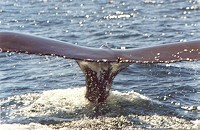
Photo (Travel Explorations): Tale of a big whale by the Canadian coastline.
Researchers have worked with this project for over 20 years. They still do not know so much about this whale. Experts will continue the examination with finding out what kind of environment in the ocean this species of whale live in, what it eat, how it breed, and whether it is unidentified and wrong classified stuffed species in museums (NTB-AFP/Aftenposten).
The number of rorqual whale species swimming in the world's oceans has jumped to eight, from six, according to new research by a team of Japanese scientists published in tomorrow's issue of the science journal Nature (according to National Geographic News by John Roach, 19 November 2003).
The research displays that rorquals commonly referred to as Bryde's whales actually represent three distinct species. Japanese researchers have determined that eight whales that were killed and collected by scientists in ocean waters around Indonesia and the Solomon Islands during the 1970s (above) belong to a distinct species of baleen whale. Scientists previously believed the specimens were Bryde's whales.
Japanese have long tradition for hunting whale and subsistence. According to High North Alliance (HNA) website, has whaling and whale meat been an important part of Japanese culture and dietary habits for more than 2000 years. Immediately following World War II the consumption of whale meat was about 45% of the total meat consumption in Japan, after which is remained at about 30%.
However, since the 1960's the supply of whale meat has gradually declined, and the consumption has been reduced in accordance. Today, the Japanese hunt both small cetaceans for commercial purposes and "IWC-whales" for research purposes (The office of the HNA is situated in Reine, the Lofoten Islands, Norway, a fishing village where 500 people live.
The organisation, whose staff consists of two full-time employees, was founded in 1991 as a result of cooperation by the Lofoten Regional Council, Lofotrådet, and the Nordland Small-type Whaler's Association - Bryde whale: The Norwegians called it "barde").
Recent discoveries of new species of elephant and other animals, show that there are still discoveries to be made in our strange world. What will be next?
Stein Morten Lund, 20 November 2003
Additional information
Full story can be read on National Geographic`s website.
Do you know how the Inuits (Eskimos in Alaska) search for whales from the coast where the ground is totally flat?
- Jumping on a trampoline to come higher up, so the can get a better view over the ocean!
Source:
Inuit Whaling, published by Inuit Circumpolar Conference, June 1992, Special issue. Author:Henry Huntington:
For several thousand years, the Eskimos in Alaska hunted the bowhead whale. Since about 800 A.D.,Inupiat and St. Laurence Island Yupik whalers have regularly taken bowheads. There are currently nine whaling villages in Alaska: the St. Laurence Island Yupik villages of Gambell and Savoonga, and the Inupiak villages of Whales, Kivalina, Point Hope, Wainwright, Barrow, Nuiqsut, and Kaktovik.
The size of the whale makes it an important part of the annual subsistence harvest. The taste of the various parts of the whale makes it prized as food. The communal nature of the hunt and the sharing of the whale give it a central place in the spiritual and physical culture of the region. The bowhead provides life, meaning, and identity to the Eskimo whalers and their communities.
Sharing the whale with the whole community, and with other communities too, is an old and highly-valued practice. At the butchering site, the parts of the whale are divided among the whaling crews, with some shares reserved for elders and widows and other parts kept for festivals. At these festivals, including Thanksgiving and Christmas as well as the traditional feasts of Nalukataq and Qagruvik, the food of the whale is given to everyone who comes to take part. In this way, tons of meat find their way throughout the region all year long.
